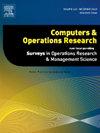An exact approach for the Vehicle Routing Problem with Demand Allocation
IF 4.1
2区 工程技术
Q2 COMPUTER SCIENCE, INTERDISCIPLINARY APPLICATIONS
引用次数: 0
Abstract
The Vehicle Routing Problem with Demand Allocation (VRPDA) involves a depot, a set of uncapacitated delivery sites, and a set of customers. Instead of directly visiting customers, their demand is allocated to a visited delivery site, incurring an assignment cost. VRPDA requires two key decisions: the first is to design a set of routes that begin and end at the depot for a fleet of homogeneous vehicles, visiting only delivery sites; the second is to assign customers to the visited delivery sites. These decisions aim to minimize the total routing and assignment costs. The solution must satisfy three primary constraints: each customer must be assigned to exactly one visited delivery site; each delivery site may be visited at most once across all routes; and the total demand of customers assigned to visited delivery sites on any given route must not exceed the vehicle capacity. To solve the VRPDA, we propose an exact branch-and-cut-and-price algorithm implemented within the VRPSolver framework. We demonstrate that the enumeration of elementary routes can only be applied in the proposed algorithm if the master formulation constraint, which prevents a delivery site from being visited more than once, is relaxed. These constraints are initially relaxed and then enforced as needed within the pricing subproblems during the course of a branch-and-bound (B&B) algorithm. Extensive experiments on benchmark instances reveal that the proposed B&B algorithm surpasses the best exact algorithms in the literature and, for the first time, finds optimal solutions for several large instances.
考虑需求分配的车辆路径问题的一种精确方法
需求分配的车辆路线问题(VRPDA)涉及一个仓库、一组无能力的交付地点和一组客户。而不是直接访问客户,他们的需求被分配到一个访问的交货地点,产生分配成本。VRPDA需要两个关键决策:首先是为同质车队设计一组从仓库开始和结束的路线,只访问交付地点;第二种是将客户分配到访问过的交付站点。这些决策的目标是最小化总路由和分配成本。该解决方案必须满足三个主要约束条件:必须将每个客户精确分配到一个访问过的交付站点;在所有路线中,每个交货地点最多只能访问一次;在任何给定的路线上,被分配到所访问的交付地点的客户的总需求不得超过车辆的容量。为了解决VRPDA问题,我们在VRPSolver框架内提出了一种精确的分支-削减-价格算法。我们证明了基本路线的枚举只能应用于所提出的算法,如果主公式约束,防止一个交付地点被访问超过一次,是宽松的。这些约束最初是放松的,然后在分支定界(B&;B)算法过程中根据需要在定价子问题中强制执行。在基准实例上的大量实验表明,所提出的B&;B算法超越了文献中最精确的算法,并且首次找到了几个大型实例的最优解。
本文章由计算机程序翻译,如有差异,请以英文原文为准。
求助全文
约1分钟内获得全文
求助全文
来源期刊

Computers & Operations Research
工程技术-工程:工业
CiteScore
8.60
自引率
8.70%
发文量
292
审稿时长
8.5 months
期刊介绍:
Operations research and computers meet in a large number of scientific fields, many of which are of vital current concern to our troubled society. These include, among others, ecology, transportation, safety, reliability, urban planning, economics, inventory control, investment strategy and logistics (including reverse logistics). Computers & Operations Research provides an international forum for the application of computers and operations research techniques to problems in these and related fields.
 求助内容:
求助内容: 应助结果提醒方式:
应助结果提醒方式:


